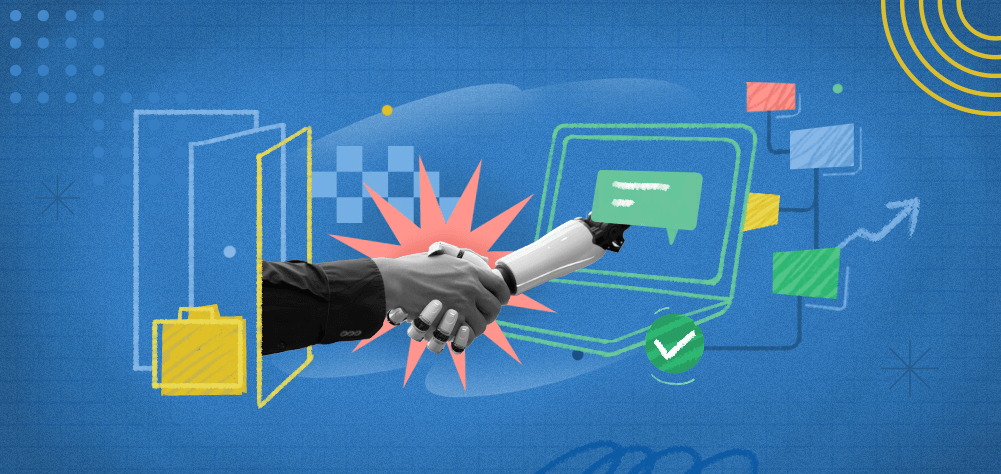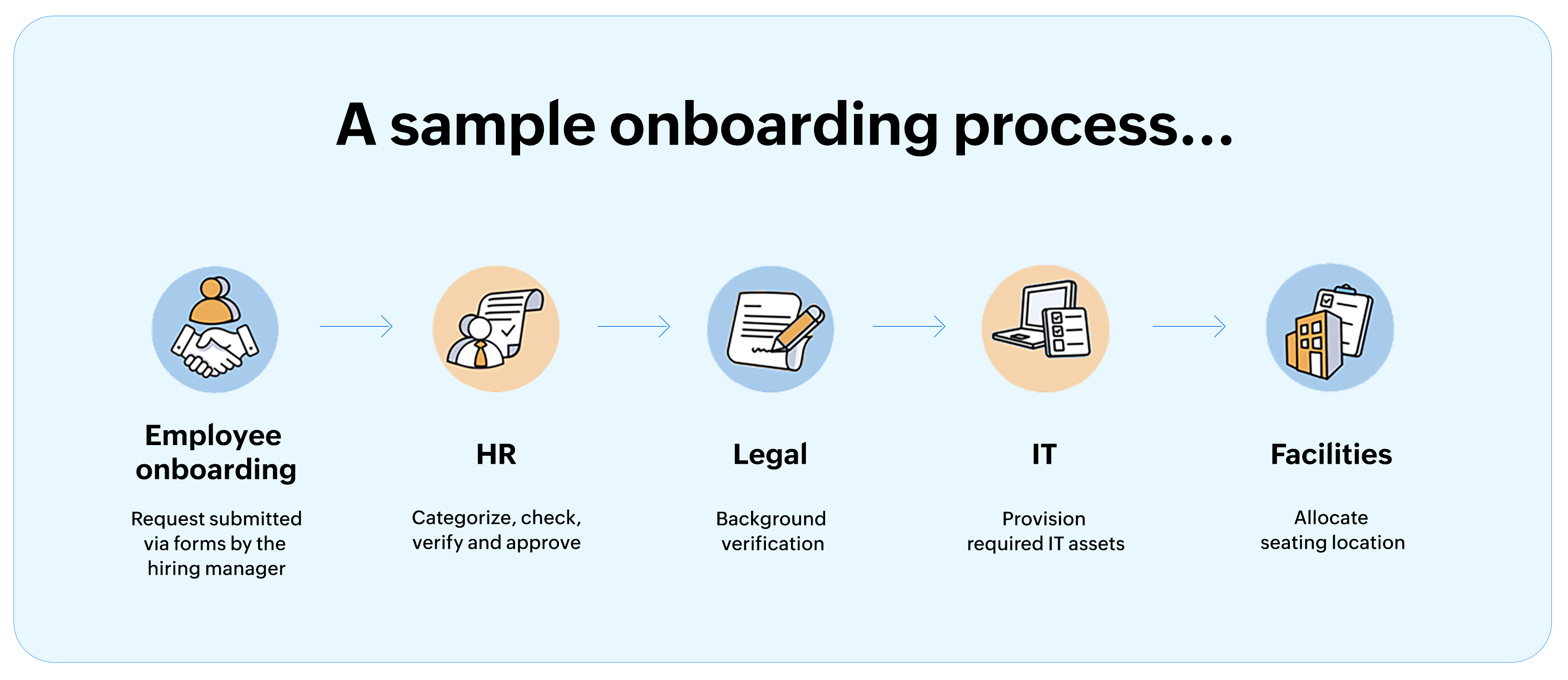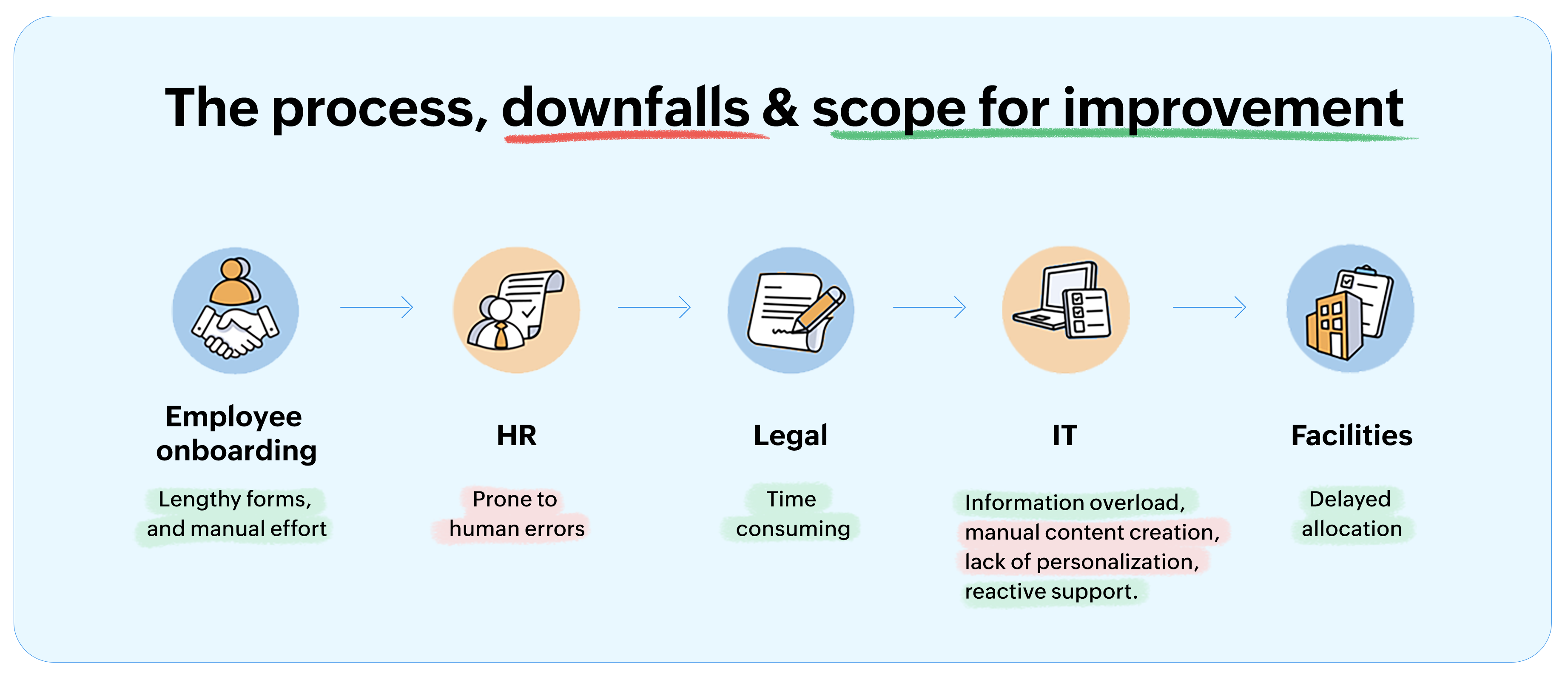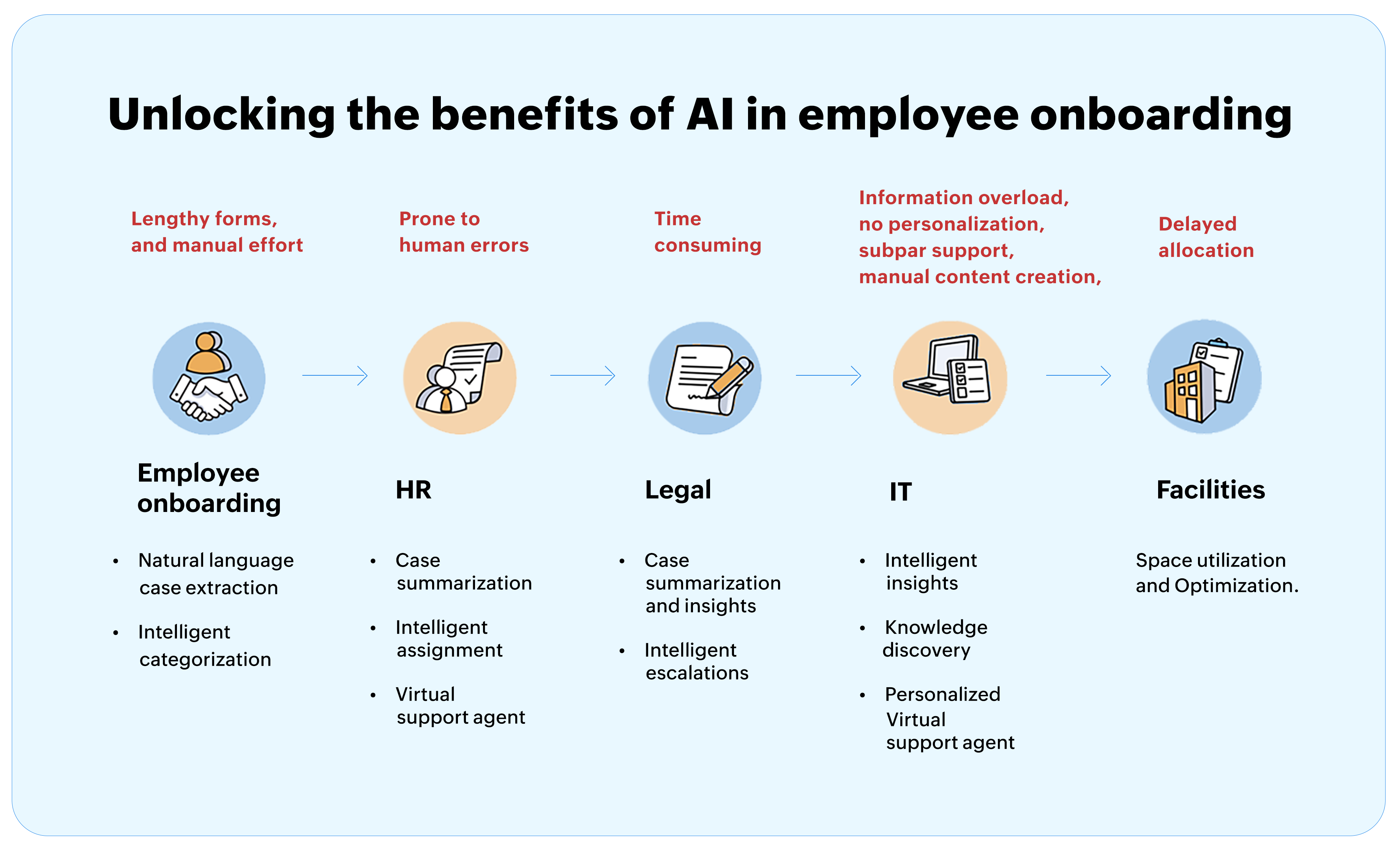Revitalizing ITSM workflows with advanced AI: Transforming
employee onboarding
March 26 | 8 mins read

With newer AI innovations revealed every day, many are eager to hop onto the AI bandwagon and harness its benefits, including IT service desks. Attracted to the promise of skyrocketing productivity levels and superior experiences, 81% of IT leaders surveyed reported that they want to embed AI into their enterprise-wide IT service operations. However, the real question is to identify use cases where AI can maximize impact and ROI.
In this article, we tackle one of the most time-consuming, manual, yet crucial ITSM operations: Employee onboarding. We dissect the challenges and explore how embedding AI capabilities across the employee onboarding workflow can eliminate process inefficiencies and enhance service delivery.
Employee onboarding workflow
Employee onboarding is inherently complex due to cross-functional dependencies between multiple teams like the HR, legal, IT and facilities departments, each with its own set of tasks. After the hiring manager submits an onboarding request, HR reviews and approves it, legal conducts background checks, IT provides the required hardware and software, and faciliies assigns an appropriate workspace. These logistical challenges are further exacerbated by the use of legacy systems and disjointed tool sets, creating process siloes while hindering coordination and communication. For instance, HR might fail to keep IT in the loop, leaving employees ill-prepared for their first day at work. Additionally, enterprise teams might expend a disproportionate amount of time and effort on manual and repetitive tasks, resulting in inefficiencies.

These challenges can be addressed to a certain extent through the adoption of ESM and orchestration engines that automate provisioning tasks. Hiring managers can simply fill out a single onboarding form from their self-service portal and submit it to the HR service desk.
Once HR checks, verifies the hiring information, and approves the ticket, department-specific tasks are created automatically in adjacent enterprise teams, establishing a shared context while facilitating coordination.
Also, visual workflows can help teams automate onboarding processes unique to their department, improving productivity. For instance, with the enriched context, the legal team can define and map out the steps involved in a complex process like background verification with visual workflows.
Meanwhile, workflow orchestration engines can connect disparate, hybrid tools and systems, empowering IT teams to orchestrate provisioning tasks, from the creation of an AD user to software installation and database updates without any manual intervention.
However, despite utilizing ESM and extensive workflow automations, various challenges can hinder smooth employee onboarding.
- Manually filling out lengthy forms can overwhelm the hiring manager, leading to inaccurate information collection.
- Rigid and outdated rule-based categorization, prioritization, and assignment of onboarding requests to an HR associate can delay the onboarding process.
- Gathering information from multiple sources, vetting extensive documentation, and ensuring regulatory compliance is time-consuming can delay the legal team's response time.
- A one-size-fits-all approach to provisioning IT assets can result in a lack of personalization, hindering employee satisfaction.
- Improper capacity planning by the facilities team can lead to resource shortages and delayed seat allocation for new hires.

The AI advantage for employee onboarding workflows
IT leaders should identify the most suitable AI capabilities that can be leveraged to address these gaps across the onboarding workflow. Let's deep dive into every phase of employee onboarding to understand how specific AI capabilities can meet your productivity and experience targets.
Request creation
When hiring managers manually fill out onboarding forms, inaccurate or incomplete information collection can result, causing processing delays. Additionally, disproportionate time and effort is expended manually to categorize and assign the onboarding request to the required teams.
Predictive AI categorizes and prioritizes requests by analyzing factors such as job type, location, and joining time. It can also take into account other criteria like department, hiring urgency, and HR associate expertise, along with onboarding trends that ensure requests are assigned to the most suitable HR associate. With advancements like natural language case extraction, AI models can capture relevant informational details including candidate name, job title, and department from offer letters and HR emails, automatically complete necessary forms, and create service requests, all of which accelerate the onboarding process.

HR team
While handling onboarding requests manually, the HR associate needs to sift through volumes of information, from request details to proof of the employee's eligibility, possibly missing critical details. This is an error-prone process that might require frequent communications with the hiring manager to fill in the gaps accurately.
With case summarization, GenAI can craft concise overviews from numerous sources to obtain hiring details that assist the HR team, including compensation, probation period, and certification requirements. Further, virtual support agents can step in to collect any additional information required by communicating directly with the hiring manager. With the assistance of AI agents, a HR onboarding agent might be able to perform all the activities to handle the onboard request, like managing communications, including drafting and sending email communications to candidates and sharing a meeting link for an online orientation meeting.
Legal team
During background verification, the legal team manually analyzes cumbersome records, including offer letters, employment agreements, and compliance forms. This time-consuming process increases the risk of missing deadlines for verification tasks, potentially delaying the onboarding process.
Here, GenAI can generate dynamic summaries of these expansive documents by highlighting key details like the candidate's identity, employment type, joining date, and more. Legal associates can also interact with LLM-powered virtual agents with retrieval-augmented generation capabilities in natural language to verify whether contract terms, such as working hours and benefits, align with regional labor laws and organizational norms to provide contextual insights. As new developments shape up, predictive AI can trigger intelligent escalations to the right stakeholders by analyzing historic trends, the role's significance, and legal complexities, ensuring proactive completion of the verification process.
IT team
The IT team usually grapples with information overload and juggles provisioning requests across multiple channels like emails, phone calls, and collaboration platforms. But a rigid asset assignment model based on predefined configurations complicates matters and fails to meet unique device requirements. As manual knowledge management mechanisms make it difficult to keep information current, employees often struggle to find accurate details to, for example, set up a VPN and enable SSO for software access. They might repeatedly turn to the service desk for support and resolution.
By correlating workload and performance needs with the job role, predictive AI can suggest suitable hardware, software, and the required access permissions. GenAI can further fine-tune this by tailoring configuration suggestions based on security requirements. Accelerating this further, in future AI agents will seek requisite approvals from service owners and then automate provisioning of software and role-based privileges by executing actions through relevant systems, from privileged access management to UEM.
To maintain a dynamic and relevant knowledge base, GenAI can scour through internal and external sources to curate and update knowledge articles while having human agents review and approve them. Leveraging user intent and sentiment, LLM-powered virtual agents deliver personalized responses to users' queries and promptly share accurate solutions drawn from the knowledge base. This way, AI helps personalize service experiences and boost productivity while fostering proactive support for employees.
Facilities team
In spite of leveraging a centralized tracking system, the Facilities team struggles with real-time visibility into seat occupancy. Unclear headcount forecasts, heterogeneous work models, and sudden organizational shifts hinder planning efforts. As a result, seat allocation is delayed, employee needs can be unmet, and office space is utilized inefficiently.
By evaluating workforce trends such as hiring patterns, attrition rates, and seasonal occupancy shifts, predictive AI can systematically recommend seating capacity expansions. GenAI enhances this further by providing role-specific and user-centric insights that ensure optimal space utilization.
In future refinements, real-time GenAI powered communication mechanisms or dedicated AI agents will keep teams well-informed with real-time, contextual updates on the onboarding process. Once the onboarding process is complete, the AI agent will then be able to send a welcome email to the new hire, and include access permissions and a tailored organizational policy document.
The benefits of leveraging AI across the onboarding process
| Department/ Scenario | Challenge | AI advantage |
|---|---|---|
Request creation |
|
|
HR team |
|
|
Legal team |
|
|
IT team |
|
|
Facilities team |
|
|
Navigating the AI-adoption journey
From case summarization to personalized virtual support agents, leveraging AI across enterprise-wide ITSM workflows unlocks peak efficiency. However, a structured AI adoption strategy that maximizes benefits while accounting for implementation costs is essential. Start small by tackling routine issues like high-volume L1 tickets. For instance, AI-powered virtual agents can instantly provide accurate solutions and remediation for common issues like application crashes and deflecting L1 tickets. Pilot targeted use cases with the right AI technologies. Then, scale AI across critical service delivery workflows to drive enterprise-wide transformation. This approach not only maximizes AI’s ROI but also accelerates outcomes, enabling organizations to deliver truly exceptional service experiences at optimal costs.





